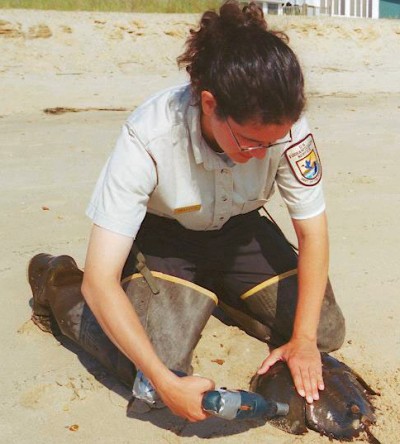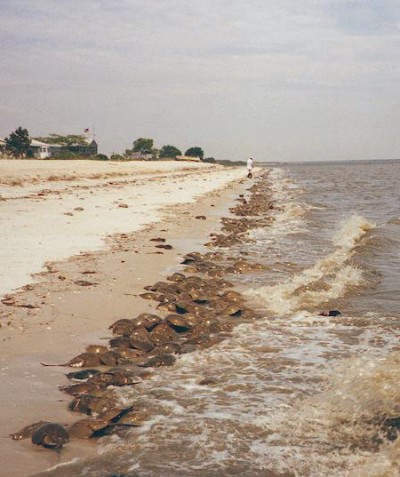
Sheila Eyler, a biologist with the U.S. Fish and Wildlife Service, tags a horseshoe crab with a unique label so it can be tracked along the Atlantic coast. (Photo courtesy of Sheila Eyler/U.S. Fish and Wildlife Service.)
ANNAPOLIS—Can you imagine looking almost exactly the same for more than 250 million years?
Well, put yourself in the shell of a horseshoe crab—a primitive-looking critter that surfs up and down the Atlantic coast and has existed long before dinosaurs roamed the Earth.
Today, biologists, biomedical companies and commercial harvesters study horseshoe crabs. Everyday people who walk along the beaches can assist researchers by reporting the location of tagged crabs they find – about 2,000 to 3,000 calls are reported annually.
This research is conducted through a federal program led by Sheila Eyler, a biologist for the U.S. Fish and Wildlife Service based in Annapolis. Horseshoe crab tagging involves putting a unique identification card on the crab with a toll-free phone number, so its movement can be tracked along the coastline, Eyler said.
“We’ve been doing this since ’99 from this office,” Eyler said. “That was my first assignment and I’ve been doing it ever since.”
The late-1990s, Eyler said, is when people started caring more about horseshoe crabs because commercial harvesters realized the crabs’ blood could be used as bait for conch snails and eels.
“We had tractor-trailers coming to the beaches and loading up all the spawning horseshoe crabs off the beaches and loading them into this truck, tens of thousands off the beaches,” she said. Spawning season is when the crabs come up to sandy beaches, usually between May and June, and make nests to lay their eggs.
Eyler disseminates thousands of tags out of her office to the tagging programs spanning the Atlantic and Gulf coasts, between New Hampshire and Florida, and as far west as Mississippi.
Jennifer Mattei, an associate professor at Sacred Heart University in Fairfield, Conn., said they last received about 4,000 tags from Eyler, down from 15,000 in past years. Funding cuts, Eyler said, is one reason they’ve had to decrease the number of tags.

Horseshoe crabs can be seen spawning in the spring. (Photo courtesy of Sheila Eyler/U.S. Fish and Wildlife Service.)
Other tagging efforts are part of a biomedical harvest, which is a “bleeding” process conducted by the Department of Natural Resources of South Carolina. Larry DeLancey, a biologist in Charleston, S.C., said they capture and tag horseshoe crabs, bleed them and put them back in the water.
“What we’re trying to do is assess the impacts of the bleeding on mortality of the horseshoe crabs,” DeLancey said. “Whatever crab makes it through the first week will [most likely] survive.”
Findings show that their blood has biomedical purposes, specifically with injection-based medicines like vaccines, which cannot be synthetically replicated, Eyler said.
Horseshoe crab eggs are also part of the Red Knot bird diet. This species of bird comes specifically to the Delaware Bay in the spring to feed on the eggs before continuing their migration to Canada.
Mattei called the Delaware Bay – which includes shores in New Jersey and Delaware – an “epicenter” for horseshoe crabs.
Glenn Gauvry, president of the Ecological Research and Development Group board in Little Creek, Del., estimated that 17 to 20 million adult horseshoe crabs spawn on the beaches of the Delaware Bay each year.
Because the Chesapeake Bay does not have very sandy shores, it is not a hub for horseshoe crabs, like the Delaware Bay. However, Eyler said Ocean City, Turkey Point and Sandy Point in Annapolis and Cove Point off the mouth of the Potomac River are hot spots for horseshoe crabs in Maryland.
Gauvry said there are many reasons for the influx of horseshoe crabs in the Delaware Bay, including the temperature, the sandy beaches for nesting, and because its low-impact winds and surf are less likely to disturb nests.
Both Gauvry and Mattei play large roles in educating the public about horseshoe crabs and making citizens an integral aspect of various research components.
Mattei is a co-leader for Project Limulus, which focuses on studying the horseshoe crab population in Long Island Sound, and uses the public to help track the animals.
“If you own a home near the shore or you like to go to the beach, you can become sort of a member of our team,” Mattei said. “We’ve trained various citizens and scientists to help collect data on the crabs on their particular beach.”
For nearly 10 years, Garth Stubbolo, an eighth grade teacher at Everett Meredith Middle School in Middletown, Del., has been taking his class to the Delaware Bay for the opportunity to do “real science.”
Stubbolo said when he introduces the kids to the crabs the reaction is often, “They ugly and they stink,” and many students are adamant about not touching them.
“Once they get down to the beach, everybody else is picking them up and looking at them and they see that they’re not harmful, boy they’re right down in the water,” Stubbolo said. “A lot of barriers get broken down.”
Making horseshoe crabs part of the class curriculum is an easy and convenient gateway to learning science and a good way to get kids out of the classroom, Stubbolo said.
“In the classroom it’s like, ‘Yeah right, yeah right,” Stubbolo said. “But once they go out on the beach and they have the wherewithal … They walk out of this feeling so empowered.”


